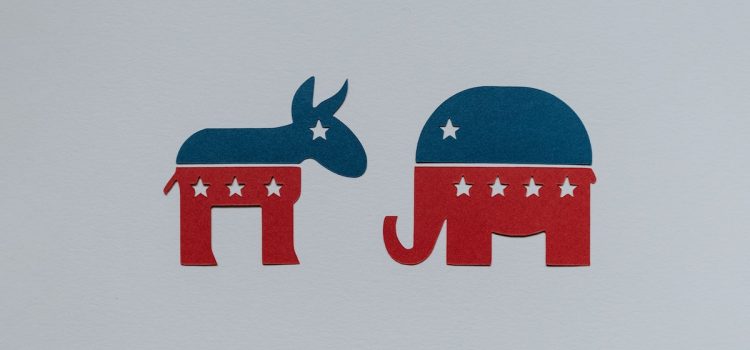

This article is an excerpt from the Shortform book guide to "Why We're Polarized" by Ezra Klein. Shortform has the world's best summaries and analyses of books you should be reading.
Like this article? Sign up for a free trial here.
How has growing political polarization in America affected Democrats and Republicans? Why are these parties impacted differently?
The Democratic and Republican parties are different, not just in their platforms, but in their culture and makeup. Ezra Klein says that this explains why political polarization affects these two major parties differently.
Continue reading to understand the polarization of political parties in America.
The Polarization of Political Parties in the US
Klein writes that, while the polarization of political parties has affected the composition and electoral strategies of both Republicans and Democrats, its effects have not been equal. Instead, he observes, the Republican Party has been far more deeply distorted by polarization than the Democratic Party.
The Diversity of the Democratic Party
Klein argues that the Democratic Party has been less vulnerable to polarization because of its diverse makeup. Democrats, he writes, are a broad coalition of different racial, religious, and other demographic groups. Within those demographic groups, there’s also lots of ideological diversity. For example, although they remain staunchly Democratic, lots of Black and Latino voters have socially conservative views, particularly on issues related to gender and sexual orientation.
The diverse composition of the party’s base acts as a moderating influence and a check on polarization: Candidates need to win over a broad demographic and ideological coalition to be nominated, and they need to compromise once they’re in office. Left-wing activists, argues Klein, do not control the Democratic Party or set its agenda—rather, they are one constituency among many that Democratic politicians need to cater to. Thus, Democrats can’t be pulled too far left, because if they did, they wouldn’t be able to hold their coalition together.
| The Democratic Shift to the Left Although Klein writes that the diversity of the Democratic coalition acts as a check on polarization, it’s worth exploring how much the Democrats have moved away from the political center, especially in recent years. In the 2020 Democratic primaries, viable candidates like Elizabeth Warren and Bernie Sanders proposed policies that would have been considered far to the left of the median voter only a few election cycles before. These policies included reparations for the descendants of enslaved people, universal childcare, a wealth tax, and forcing corporations to reserve 40% of board seats for workers. Moreover, self-identified liberals comprise a far larger share of the Democratic base than they did a generation ago. In 1994, self-identified moderates made up half the party, while liberals made up only a quarter. In 2020, liberals represented half the party, while moderates represented only a third. And this move to the left may be influencing how the broader American electorate views the party: A 2019 Quinnipiac poll showed that nearly half the country thinks the Democratic Party has moved too far to the left. |
The Uniformity of the GOP
According to Klein, the GOP is more vulnerable to polarization because of its comparatively homogeneous and uniform composition. Unlike the Democratic Party, the GOP is dominated by a single ideological and demographic group—white conservative Christians.
Klein writes that this uniformity does give Republicans some real political advantages: They’re able to achieve a level of internal cohesion and discipline that Democrats lack. Republican politicians don’t have to cater to as many groups with competing interests to keep their coalition together.
But, because the party is largely synonymous with a single identity group, Republican voters are also more susceptible to identity-based appeals and provocations than their Democratic counterparts.
(Shortform note: Although Klein discusses the ethnic homogeneity of the GOP, it’s worth noting that the GOP has shown strength with certain segments of the nonwhite electorate. In 2020, Republican Donald Trump dramatically increased his share of the Hispanic vote—earning 38% of the group’s vote, a 10 percentage-point increase over his performance with them in 2016.)

———End of Preview———
Like what you just read? Read the rest of the world's best book summary and analysis of Ezra Klein's "Why We're Polarized" at Shortform.
Here's what you'll find in our full Why We're Polarized summary:
- Why bipartisan cooperation is becoming increasingly difficult in the US
- The origins of modern political polarization and its impacts on the parties
- Ideas for how we might depolarize our politics






